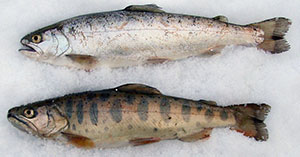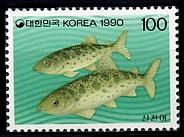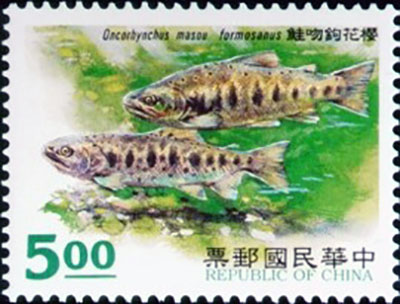Oncorhynchus masou Brevoort, 1856

(Da: it.wikipedia.org)
Phylum: Chordata Haeckel, 1874
Subphylum: Vertebrata Lamarck J-B., 1801
Classe: Actinopterygii Klein, 1885
Ordine: Salmoniformes Rafinesque, 1810
Famiglia: Salmonidae Jarocki, 1822
Genere: Oncorhynchus Suckley, 1861
English: Cherry salmon
Specie e sottospecie
Il genere attualmente annovera le seguenti specie: Oncorhynchus masou ssp. formosanus DS Jordan & Oshima, 1919 - Oncorhynchus masou ssp. macrostomus Günther, 1877 - Oncorhynchus masou ssp. ishikawae Brevoort, 1856 - Oncorhynchus masou ssp. rhodurus DS Jordan & EA McGregor , 1925 - Oncorhynchus masou var. iwame Seiro Kimura & M. Nakamura, 1961.
Descrizione
L'aspetto generale di questa specie non è diverso da quello degli altri Oncorhynchus diffusi sulle coste americane. La colorazione degli esemplari non ancora discesi in mare o che compiono il loro intero ciclo in acqua dolce è notevole per la presenza di 7-10 macchie brune ovali allungate sui fianchi, simili alle macchie parr dei giovani salmoni atlantici o delle trote sarde ma molto più incise e definite. Spesso la linea laterale è accompagnata da una linea rossa o da punti rossi sparsi. In mare gli esemplari hanno una livrea azzurra o grigio acciaio simile a quella dei congeneri. Quando inizia la riproduzione invece la livrea diventa sgargiante: nera o bruno scura su dorso e ventre con fianchi percorsi da bande trasversali rosso cremisi che si fondono in una fascia rossa irregolare a metà altezza del corpo. Misura fino a circa 80 cm per 10 kg di peso. In mare si ciba soprattutto di crostacei planctonici e di pesciolini. In acqua dolce cattura soprattutto insetti e secondariamente crostacei e pesci. Le uova sono deposte in una buca sul fondo e abbandonate dai genitori. Le forme dulciacquicole si riproducono in inverno, più volte nella vita, come le trote di torrente mentre le forme migratrici si riproducono una sola volta nella vita, dopo la quale i riproduttori muoiono come avviene per la generalità degli Oncorhynchus anadromi. Al contrario che nei congeneri, nei quali la mortalità è totale, alcuni esemplari sopravvivono, in genere maschi, ed in tal caso restano in acqua dolce fino alla stagione successiva, quando possono riprodursi nuovamente. Il giovane per i primi tempi dopo la discesa a mare si mantiene nei pressi dell'estuario del fiume da cui proviene. Questa specie ha importanza per la pesca commerciale e soprattutto per l'acquacoltura delle regioni dove vive. È una preda molto ambita anche per i pescatori sportivi. Le carni sono simili a quelle di tutti i salmoni, ottime.
Diffusione
Questa specie è endemica dell'Oceano Pacifico nordoccidentale, si incontra nel mar di Okhotsk e nel mar del Giappone. Risale i fiumi del Giappone settentrionale e della Corea orientale.
Sinonimi
= Oncorhynchus rhodurus Jordan and McGregor in Jordan and Hubbs, 1925.
Bibliografia
–Bartel, Rebecca; Oberhauser, Karen; De Roode, Jacob; Atizer, Sonya (February 2011). "Monarch butterfly migration and parasite transmission in eastern North America". Ecology. 92 (2): 342-351.
–Smiley, Charles J. "Late Cenozoic History of the Pacific Northwest" (PDF). Association for the Advancement of Science: Pacific Division.
–McPhail, J.D.; Strouder, D.J. (1997). "Pacific Salmon and Their Ecosystems: Status and Future Options". The Origin and Speciation of Oncorhynchus. New York, New York: Chapman & Hall.
–Montgomery, David R. (2000). "Coevolution of the Pacific Salmon and Pacific Rim Topography" (PDF). Department of Geological Sciences, University of Washington.
–Robert T. Lackey (2003). "Pacific Northwest Salmon: Forecasting Their Status in 2100" (PDF). U.S. Environmental Protection Agency.
–Robert T. Lackey (2008). "Salmon Decline in Western North America: Historical Context" (PDF). Department of Fisheries and Wildlife Oregon State University.
–Behnke, Robert J. (2002). "Genus Oncorhynchus". Trout and Salmon of North America. Tomelleri, Joseph R. (illust.). The Free Press. pp. 10-21.
–Oke, K. B.; Cunningham, C. J.; Westley, P. a. H.; Baskett, M. L.; Carlson, S. M.; Clark, J.; Hendry, A. P.; Karatayev, V. A.; Kendall, N. W.; Kibele, J.; Kindsvater, H. K.; Kobayashi, K. M.; Lewis, B.; Munch, S.; Reynolds, J. D.; Vick, G. K.; Palkovacs, E. P. (19 August 2020). "Recent declines in salmon body size impact ecosystems and fisheries". Nature Communications. 11 (1): 4155.
–"Alaska's salmon are getting smaller, affecting people and ecosystems". phys.org.
–Ricker, W. E. (1981). "Changes in the average size and average age of Pacific salmon". Canadian Journal of Fisheries and Aquatic Sciences. 38 (12): 1636-1656.
–Ricker, W. E. 1995. Trends in the average size of Pacific salmon in Canadian catches. In Climate change and northern fish populations, pp. 563-602. Ed. by R. J. Beamish. Canadian Special Publication of Fisheries and Aquatic Sciences 121. Rand, P.S. 2011. Oncorhynchus nerka. In: IUCN 2012. IUCN Red List of Threatened Species. Version 2012.
–Rand, P.S. 2011. Oncorhynchus nerka. In: IUCN 2012. IUCN Red List of Threatened Species.
–Beamish, R (1997). "Hatchery and wild production of Pacific salmon in relation to large-scale, natural shifts in the productivity of the marine environment". ICES Journal of Marine Science. 54 (6): 1200-1215.
–"Risks to Wild Populations from Hatchery Fish - Salmon Hatchery Q & As." Northwest Fisheries Science Center. N.p., n.d. Web.
–"Salmon Hatcheries Overview | Washington Department of Fish & Wildlife." Washington Department of Fish & Wildlife. N.p., n.d. Web.
–Groot, Cornelis, and Leo Margolis. (1991) Pacific salmon life histories. UBC press.
–IIshida, Y.; Ito, S.; Kaeriyama, M.; McKinnell, M.; Nagasawa, K. (1993). "Recent changes in age and size of chum salmon (Oncorhynchus keta) in the North Pacific Ocean and possible causes". Canadian Journal of Fisheries and Aquatic Sciences. 50 (2): 290-295.
–Bigler, B. S.; Welch, D. W.; Helle, J. H. (1996). "A review of size trends among North Pacific salmon (Oncorhynchus spp.)". Canadian Journal of Fisheries and Aquatic Sciences. 53 (2): 455-465.

|
Stato: Korea (South) |
|---|

|
Data: 27/07/1995
Emissione: Ittiofauna Stato: China (Taiwan) |
|---|